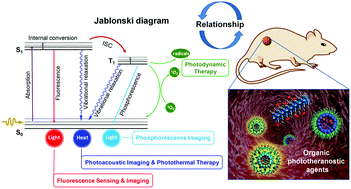Design of superior phototheranostic agents guided by Jablonski diagrams
Abstract
Phototheranostics represents a promising direction for modern precision medicine, which has recently attracted great research interest from multidisciplinary research areas. Organic optical agents including small molecular fluorophores, semiconducting/conjugated polymers, aggregation-induced emission luminogens, etc. with tuneable photophysical properties, high biosafety and biocompatibility, facile processability and ease of functionalization have delivered encouraging performance in disease phototheranostics. This review summarizes the recent progress of organic phototheranostic agents with an emphasis on the main strategies to manipulate the three excitation energy dissipation pathways, namely, radiative decay, thermal deactivation, and intersystem crossing, with the assistance of a Jablonski diagram, which particularly showcases how the Jablonski diagram has been guiding the design of organic agents from molecule to aggregate levels to promote the disease phototheranostic outcomes. Molecular design and nanoengineering strategies to modulate photophysical processes of organic optical agents to convert the absorbed photons into fluorescent/phosphorescent/photoacoustic signals and/or photodynamic/photothermal curing effects for improved disease phototheranostics are elaborated. Noteworthily, adaptive phototheranostics with activatable and transformable functions on demand, and regulation of excitation such as chemiexcitation to promote the phototheranostic efficacies are also included. A brief summary with the discussion of current challenges and future perspectives in this research field is further presented.

- This article is part of the themed collection: 2020 Emerging Investigators


 Please wait while we load your content...
Please wait while we load your content...